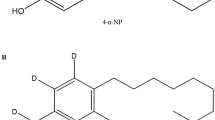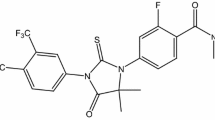Abstract
Female rats poisoned with multiple LD50s of soman or tabun have been shown previously to respond to the protective effects of HI-6 more positively than male rats. This present study was designed first to determine the distribution pattern and concentration of [14C] HI-6 in rats, and secondly, to determine the possibility that HI-6 might be located in high concentrations in critical tissues in the female as opposed to the male. To these ends, [14C] HI-6 was administered to groups of male and female rats and its radiolabelled distribution determined by whole body autoradiography and/or by measurement of its actual concentration, by scintillation spectrometry. The experiments were repeated in the presence of 2 × LD50 soman and supporting therapy with atropine. In both sexes, HI-6 levels were highest in the kidney, followed in order by cartilage >plasma >liver >heart >lung > diaphragm >brain and spinal cord. The relative distribution in the two sexes was confirmed by both methods and was not significantly altered in the presence of soman and atropine. The lack of a measurable difference in tissue distribution of [14C] HI-6 derived radioactivity between males and females suggested that the hormone-dependent difference in the protective effects previously observed was not due to selective accumulation of [14C] HI-6 in organs believed to be important in its therapeutic activity, such as brain or diaphragm.
Similar content being viewed by others
References
Arnold AP, Gorski RA (1984) Gonadal steroid induction of structural sex differences in the central nervous system. Ann Rev Neurosci 7: 413–442
Ashani Y, Catravas GN (1981) Seizure-induced changes in the permeability of the blood brain barrier following administration of anticholinesterase drugs to rats. Biochem Pharmacol 30: 2593–2601
Clement JG (1982) HI-6: reactivation of central and peripheral acetylcholinesterase following inhibition by soman, sarin and tabun in vivo in the rat. Biochem Pharmacol 31: 1283–1287
Fand I, McNally WP (1981) The technique of whole-body autoradiography. In: Johnson JE (ed) Current trends in morphological techniques 2. CRC Press, Boca Raton, Florida, pp 1–28
Kato R (1975) Sex-related differences in drug metabolism. In: Di Carlo FJ (ed) Drug metabolism reviews, Vol. 3. Marcell Dekker, New York, pp 1–32
Kepner LA, Wolthuis OL (1978) A comparison of the oximes HS-6 and HI-6 in the therapy of soman intoxications in rodents. Eur J Pharmacol 48: 377–382
Larson B, Ullberg S (1981) Whole-body autoradiography. J Histochem Cytochem 29: 216–225
Ligtenstein DA, Kossen SP (1983) Kinetic profile in blood and brain of the cholinesterase reactivating oxime HI-6 after intravenous administration to the rat. Toxicol Appl Pharmacol 71: 177–183
Ligtenstein DA, Moes GWH, Kossen SP (1988) In vivo distribution of organophosphate antidotes: autoradiography of [14C] HI-6 in the rat. Toxicol Appl Pharmacol 92: 324–329
Lipp JA, Dola T (1980) Comparison of the efficacy of HI-6 versus HS-6 when compared with atropine, pyridostigmine and clonazepam for soman poisoning in the monkey. Arch Int Pharmacodyn 246: 138–148
Lundy PM, Shaw RK (1983) Modification of cholinergically induced convulsive activity and cyclic GMP level in the CNS. Neuropharmacology 22: 55–63
Lundy PM, Goulet J-C, Hand BT (1989) Hormone and dose schedule protection by HI-6 against soman and tabun poisoning. Fundam ApplToxicol 12: 595–603
Martinez JL, Koda L (1988) Penetration of fluorescein into the brain: a sex difference. Brain Res 450: 81–85
Waser PG, Sammet R, Schonenberger E, Sin Ren AC (1986) Pharmacokinetics of [14C] sarin and its changes by obidoxime and pralidoxime. In: Hanin I (ed) Dynamics of cholinergic function, Plenum Press, New York, pp 743–755
Wolthuis DL, Berends F, Meeter E (1981) Problems in the therapy of soman poisoning. Fundam Appl Toxicol 1: 183–192
Author information
Authors and Affiliations
Rights and permissions
About this article
Cite this article
Lundy, P.M., Hand, B.T., Broxup, B.R. et al. Distribution of the bispyridinium oxime [14C] HI-6 in male and female rats. Arch Toxicol 64, 377–382 (1990). https://doi.org/10.1007/BF01973459
Received:
Revised:
Accepted:
Issue Date:
DOI: https://doi.org/10.1007/BF01973459




